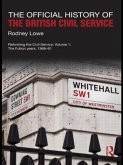- Gebundenes Buch
- Merkliste
- Auf die Merkliste
- Bewerten Bewerten
- Teilen
- Produkt teilen
- Produkterinnerung
- Produkterinnerung
Sakade challenges the narrative that the focus of British manufacturing went "from Empire to Europe" and argues rather that, following the Second World War, the key relationship was in fact trans-Atlantic. A valuable read for historians of British aviation and more widely of 20th century British Industry.
Andere Kunden interessierten sich auch für
![The Official History of the British Civil Service The Official History of the British Civil Service]() Rodney LoweThe Official History of the British Civil Service169,99 €
Rodney LoweThe Official History of the British Civil Service169,99 €![The Official History of the British Civil Service The Official History of the British Civil Service]() Rodney LoweThe Official History of the British Civil Service178,99 €
Rodney LoweThe Official History of the British Civil Service178,99 €![Britain since 1688 Britain since 1688]() Stephanie BarczewskiBritain since 1688151,99 €
Stephanie BarczewskiBritain since 1688151,99 €![The British Empire The British Empire]() Philippa LevineThe British Empire167,99 €
Philippa LevineThe British Empire167,99 €![Russia Russia]() Christopher J. WardRussia168,99 €
Christopher J. WardRussia168,99 €![The British and American Intelligence Divisions in Occupied Germany, 1945-1955 The British and American Intelligence Divisions in Occupied Germany, 1945-1955]() Luke Daly-GrovesThe British and American Intelligence Divisions in Occupied Germany, 1945-195598,99 €
Luke Daly-GrovesThe British and American Intelligence Divisions in Occupied Germany, 1945-195598,99 €![The British and American Intelligence Divisions in Occupied Germany, 1945-1955 The British and American Intelligence Divisions in Occupied Germany, 1945-1955]() Luke Daly-GrovesThe British and American Intelligence Divisions in Occupied Germany, 1945-195598,99 €
Luke Daly-GrovesThe British and American Intelligence Divisions in Occupied Germany, 1945-195598,99 €-
-
-
Sakade challenges the narrative that the focus of British manufacturing went "from Empire to Europe" and argues rather that, following the Second World War, the key relationship was in fact trans-Atlantic. A valuable read for historians of British aviation and more widely of 20th century British Industry.
Produktdetails
- Produktdetails
- Verlag: Routledge
- Seitenzahl: 274
- Erscheinungstermin: 10. Dezember 2021
- Englisch
- Abmessung: 240mm x 161mm x 19mm
- Gewicht: 578g
- ISBN-13: 9780367651206
- ISBN-10: 0367651203
- Artikelnr.: 62634660
- Herstellerkennzeichnung
- Libri GmbH
- Europaallee 1
- 36244 Bad Hersfeld
- gpsr@libri.de
- Verlag: Routledge
- Seitenzahl: 274
- Erscheinungstermin: 10. Dezember 2021
- Englisch
- Abmessung: 240mm x 161mm x 19mm
- Gewicht: 578g
- ISBN-13: 9780367651206
- ISBN-10: 0367651203
- Artikelnr.: 62634660
- Herstellerkennzeichnung
- Libri GmbH
- Europaallee 1
- 36244 Bad Hersfeld
- gpsr@libri.de
Takeshi Sakade is Associate Professor in Graduate School of Economics at Kyoto University, Japan.
Introduction: Britain's 'new role' between Europe and the US after 1945 Part I. The Post
War British Aircraft Industry, 1943
1964 1. The origins of Anglo
American production collaboration in the first jet
age (1943
56) 2. Sandy's Defence White Paper and the Rationalisation of the British Aircraft Industry, 1957
60 3. BOAC's Financial Crisis and the End of the "Fly British" Policy, 1963
66 Part II. The British Dilemma. 1964
1969 4. The Cancellation of Britain's Top Projects, 1963
65 5. The Politics Behind the Plowden Doctrine: European and American Alternatives for the British Aircraft Industry 6. The "European Technological Community" and the Anglo
German MRCA project, 1966
69 Part III. European cooperative airliner projects and Anglo
American Industrial Collaboration, 1968
1982 7. The second jet age and the bankruptcy of Rolls
Royce, 1967
71 8. Trapped in a Loveless Marriage: The Anglo
French Concorde crisis of 1974 9. Playing a Double Game: The British aircraft industry in the third jet age Conclusion
War British Aircraft Industry, 1943
1964 1. The origins of Anglo
American production collaboration in the first jet
age (1943
56) 2. Sandy's Defence White Paper and the Rationalisation of the British Aircraft Industry, 1957
60 3. BOAC's Financial Crisis and the End of the "Fly British" Policy, 1963
66 Part II. The British Dilemma. 1964
1969 4. The Cancellation of Britain's Top Projects, 1963
65 5. The Politics Behind the Plowden Doctrine: European and American Alternatives for the British Aircraft Industry 6. The "European Technological Community" and the Anglo
German MRCA project, 1966
69 Part III. European cooperative airliner projects and Anglo
American Industrial Collaboration, 1968
1982 7. The second jet age and the bankruptcy of Rolls
Royce, 1967
71 8. Trapped in a Loveless Marriage: The Anglo
French Concorde crisis of 1974 9. Playing a Double Game: The British aircraft industry in the third jet age Conclusion
Introduction: Britain's 'new role' between Europe and the US after 1945 Part I. The Post-War British Aircraft Industry, 1943-1964 1. The origins of Anglo-American production collaboration in the first jet-age (1943-56) 2. Sandy's Defence White Paper and the Rationalisation of the British Aircraft Industry, 1957-60 3. BOAC's Financial Crisis and the End of the "Fly British" Policy, 1963-66 Part II. The British Dilemma. 1964-1969 4. The Cancellation of Britain's Top Projects, 1963-65 5. The Politics Behind the Plowden Doctrine: European and American Alternatives for the British Aircraft Industry 6. The "European Technological Community" and the Anglo-German MRCA project, 1966-69 Part III. European cooperative airliner projects and Anglo-American Industrial Collaboration, 1968-1982 7. The second jet age and the bankruptcy of Rolls-Royce, 1967-71 8. Trapped in a Loveless Marriage: The Anglo-French Concorde crisis of 1974 9. Playing a Double Game: The British aircraft industry in the third jet age Conclusion
Introduction: Britain's 'new role' between Europe and the US after 1945 Part I. The Post
War British Aircraft Industry, 1943
1964 1. The origins of Anglo
American production collaboration in the first jet
age (1943
56) 2. Sandy's Defence White Paper and the Rationalisation of the British Aircraft Industry, 1957
60 3. BOAC's Financial Crisis and the End of the "Fly British" Policy, 1963
66 Part II. The British Dilemma. 1964
1969 4. The Cancellation of Britain's Top Projects, 1963
65 5. The Politics Behind the Plowden Doctrine: European and American Alternatives for the British Aircraft Industry 6. The "European Technological Community" and the Anglo
German MRCA project, 1966
69 Part III. European cooperative airliner projects and Anglo
American Industrial Collaboration, 1968
1982 7. The second jet age and the bankruptcy of Rolls
Royce, 1967
71 8. Trapped in a Loveless Marriage: The Anglo
French Concorde crisis of 1974 9. Playing a Double Game: The British aircraft industry in the third jet age Conclusion
War British Aircraft Industry, 1943
1964 1. The origins of Anglo
American production collaboration in the first jet
age (1943
56) 2. Sandy's Defence White Paper and the Rationalisation of the British Aircraft Industry, 1957
60 3. BOAC's Financial Crisis and the End of the "Fly British" Policy, 1963
66 Part II. The British Dilemma. 1964
1969 4. The Cancellation of Britain's Top Projects, 1963
65 5. The Politics Behind the Plowden Doctrine: European and American Alternatives for the British Aircraft Industry 6. The "European Technological Community" and the Anglo
German MRCA project, 1966
69 Part III. European cooperative airliner projects and Anglo
American Industrial Collaboration, 1968
1982 7. The second jet age and the bankruptcy of Rolls
Royce, 1967
71 8. Trapped in a Loveless Marriage: The Anglo
French Concorde crisis of 1974 9. Playing a Double Game: The British aircraft industry in the third jet age Conclusion
Introduction: Britain's 'new role' between Europe and the US after 1945 Part I. The Post-War British Aircraft Industry, 1943-1964 1. The origins of Anglo-American production collaboration in the first jet-age (1943-56) 2. Sandy's Defence White Paper and the Rationalisation of the British Aircraft Industry, 1957-60 3. BOAC's Financial Crisis and the End of the "Fly British" Policy, 1963-66 Part II. The British Dilemma. 1964-1969 4. The Cancellation of Britain's Top Projects, 1963-65 5. The Politics Behind the Plowden Doctrine: European and American Alternatives for the British Aircraft Industry 6. The "European Technological Community" and the Anglo-German MRCA project, 1966-69 Part III. European cooperative airliner projects and Anglo-American Industrial Collaboration, 1968-1982 7. The second jet age and the bankruptcy of Rolls-Royce, 1967-71 8. Trapped in a Loveless Marriage: The Anglo-French Concorde crisis of 1974 9. Playing a Double Game: The British aircraft industry in the third jet age Conclusion









